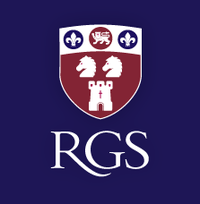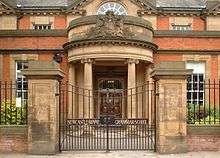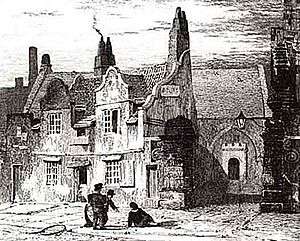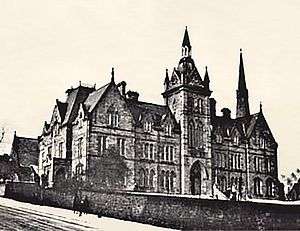Royal Grammar School, Newcastle upon Tyne
 | |
| Motto |
Discendo Duces (By Learning, You Will Lead) |
|---|---|
| Established | 1525 |
| Type | Independent day school |
| Headmaster | Dr. Bernard Trafford |
| Founder | Thomas Horsley |
| Location |
Eskdale Terrace Newcastle upon Tyne NE2 4DX England Coordinates: 54°58′58″N 1°36′32″W / 54.982896°N 1.608864°W |
| DfE URN | 108549 Tables |
| Staff | 91 |
| Students | 1,247 |
| Gender | Coeducational |
| Houses | Collingwood, Eldon, Horsley, Stowell |
| Former pupils | Old Novocastrians |
| Website | Royal Grammar School |
Royal Grammar School, Newcastle upon Tyne, usually abbreviated as RGS, is a selective British independent school for pupils aged between 7 and 18 years. Founded in 1525 by Thomas Horsley, the Mayor of Newcastle upon Tyne, it received royal foundation by Queen Elizabeth I and is the city's oldest institution of learning.
The School is located in Newcastle upon Tyne, in North East England, and is a member of the Headmasters' and Headmistresses' Conference. In 2008, RGS became fully co-educational after 450 years as an all boys' school. It has a current enrollment of more than 1,200 pupils.
RGS has a long list of distinguished former pupils including academics, politicians and British aristocracy.[1] Former students are known as Old Novocastrians or Old Novos ("Novocastrian" is macaronic Latin for "citizen of Newcastle"). In 2012 the Sunday Times Schools Guide named RGS the top performing school in the North of England based on academic results from A-levels and GCSEs.[2][3]
In 2015, RGS was named Best School in the North of England by the Sunday Times Schools Guide .[4] In the October of 2015, the school was also the team base for the Scottish national rugby union team during the 2015 Rugby World Cup.[5]
History
The RGS was founded in 1525[6] by Thomas Horsley, within the grounds of St Nicholas' Church, Newcastle. Planning is believed to have begun as early as 1477. The site has moved five times since then, most recently to Jesmond in 1906.[7] The new school building was officially opened on 17 January 1907.[8]
An 1868 description reads:
There are many public schools, the principal one being the Royal Free Grammar school founded in 1525 by Thomas Horsley, Mayor of Newcastle, and made a royal foundation by Queen Elizabeth. It is held in the old hall of St. Mary's Hospital, built in the reign of James I., and has an income from endowment of about £500, besides a share in Bishop Crew's 12 exhibitions at Lincoln College, Oxford, lately abolished, and several exhibitions to Cambridge. The number of scholars is about 140. Hugh Moises, and Dawes, author of "Miscellanea Critica," were once head-masters, and many celebrated men have ranked among its pupils, including W. Elstob, Bishop Ridley, Mark Akenside, the poet, Chief Justice Chambers, Brand, the antiquary and town historian, Horsley, the antiquary, and Lords Eldon, Stowell, and Collingwood.[6]
George III, on reading one of Admiral Collingwood's despatches after Trafalgar, asked how the seaman had learned to write such splendid English, but he answered himself, recalling that, along with Eldon and Stowell, he had been a pupil of Hugh Moises: "I forgot. He was one of Moises' boys."[9]
Description

The RGS is located opposite the Newcastle Prep School, and Newcastle High School for Girls, a single-sex girls' school formed through the merger of the Central High and Church High girls' schools. The RGS often shares activities such as drama and school trips with them.
Throughout the school (years 3–13) are four houses, named Collingwood (yellow), Eldon (green), Horsley (blue) and Stowell (red), although the Junior School previously had separate houses, named after colours (red, white, and blue). The Senior School is located on Eskdale Terrace. The Junior School was housed on the adjoining Lambton Road, but a new Junior School on the main school site has been in use since September 2006.
The RGS has Combined Cadet Force (CCF) Army and Navy contingents, open to both boys and girls. The CCF provides leadership training by means of military exercises. Cadets have weekly training sessions after school, and opportunities to go on extended training and adventure trips during the holidays. The Army section of NRGS CCF are affiliated to the Royal Regiment of Fusiliers, and the Navy Section are affiliated to HMS Calliope which is situated on the Tyne next to the Baltic.[10]
In recent years the school's debating society has become increasingly prominent within the debating community. In October 2004 the school hosted the first Northern Junior Debating Championship, which has now become an annual competition. It is notable for being the first competition of the school calendar. The society also regularly enters teams for other competitions, and has reached the finals' day of both the Oxford Union and Cambridge Union schools' competitions in recent years, winning the Cambridge Union competition in 2010. At a junior level, RGS reached the final of the International Competition for Young Debaters in 2006 and 2007, and won the Northern Junior Debating Competition in 2005, 2006, 2010 and 2014.[11]
The school has its own swimming pool and gym; a new gym and pool which have recently opened. The primary sports that are played at RGS are rugby, hockey, fencing, football, netball, cricket, swimming and athletics.
Dr. Bernard St. John Trafford has been headmaster since 2008. He was previously headmaster of Wolverhampton Grammar School.[12] His predecessor, James F X Miller, retired in 2008.[13][14] The Second Master is Tony Bird. There are 91 members of teaching staff in the Senior School, 6 of whom are part-time. In the Junior School there are a further 6 members of teaching staff including the Headmaster Roland Craig (since 1999). There are also approximately 68 members of maintenance staff under the management of Richard Metcalfe, the school Bursar, as well as 14 private music tutors.
The RGS school uniform was updated for all new pupils as of September 2006, and was then updated further in 2012.
The school magazine, Novo, comes out annually and features trip reports, society and sporting news, outstanding poetry and artwork, and a section on recently joined or departing staff. A student-run newspaper, the Issue, came into being in the late 1990s; after a period of inactivity, it was relaunched as the re-Issue in September 2003 and contained reviews, opinion columns, road-tests and humour pieces. It was famous for breaking the big story that football was to be introduced as a core sport alongside rugby. It ran roughly twice per term until its demise in summer 2005, but was replaced in early 2006 by The Grammar, a more serious and formal piece than the photocopied re-Issue, which has both printed and internet sections. At the end of the 2009–2010 academic year, The Grammar folded. In 2011 a new magazine called Vox was set up by a group of 6th Form students, and is currently out of print.
In December 2006, the school was deeply shocked by the sudden death of former Head of Drama, Jeremy Thomas. Jeremy had left the school in the summer of 2005, having made an incalculable contribution to the school's drama output for nearly three decades. A tribute in his honour was performed in early 2007, attended by many former pupils and teachers, in the newly-opened Performing Arts Centre, for which Jeremy had campaigned for many years, yet tragically never saw.
Since 1965, the school has held a "Prizegiving" ceremony each November, to recognise academic achievement and bring the school together. It was held at the Newcastle City Hall, since no space on campus could hold all teachers, students, and parents. Due to declining interest by parents, students, and teachers, the school replaced this in 2007 with a series of smaller gatherings and a public festival. However, in 2009, Headmaster Bernard Trafford announced that a new Prizegiving ceremony "RGS Day" would be hosted on the Saturday of the penultimate week of the school year. This event would invite parents of all year groups to come and would involve the Prizegivings of the entire school as well as musical and dramatic performances, sporting events, a chance for Old Novos to return to the school and the opportunity for various departments to exhibit themselves. The Junior School's Prizegiving will be held the following Wednesday but they will also have activities on RGS Day.
Buildings and grounds
The RGS's main buildings are in a complex located on Eskdale Terrace, Jesmond, Newcastle upon Tyne.
There have since been a number of large-scale building operations to provide the school with better facilities and to accommodate for the expansion of the school as it prepared to admit girls at all major entrance points from September 2006.
In 1997, Professor Richard Dawkins opened the new Science and Technology Centre (STC), with Physics and Design & Technology laboratories downstairs, and Chemistry and Biology laboratories upstairs. In 2003 the STC was renamed The Neil Goldie Centre in memory of Neil Goldie, who died earlier that year. At the time he was the school's Head of Science and Technology.
In 1996, a new Sports' Hall containing basketball courts and updated gymnastics facilities was opened. The building also provides facilities for table tennis, fencing, and weight-training, plus a gymnasium available to pupils of the school in their free time. During the height of summer examination seasons the hall is used for pupils sitting public examinations and is closed to all other activities.
In 2005, the music and economics block was demolished. A new Performing Arts Centre and Modern Languages department was completed in September 2006. It includes a 300-seat auditorium for school concerts and productions, a musical recital hall, a drama/dance studio, recording facilities, a band room, a percussion room, and a number of classrooms where modern languages and music will be taught. The gala opening concert was in October 2006. Also in 2005, an extension to the school's dining hall which has been created as the new Junior School site. Coordinated with this development was the renovation of the 6th form common room to amalgamate the previously separated lower 6th and upper 6th quarters. The re-development allowed the site of the lower 6th form room to be converted to a library extension. The new common room included a tuck-shop, computer pods, and two miscellaneous annexes.
A floodlit all-weather surface has been in use since January 2006, on land that once was part of the school field. Aside from the school field, which is primarily used for rugby union, the school also owns land in nearby Jesmond for sports use. This was given to the school in recompense for the land it lost when the flyover was created at the top of the school- eating into some of the land owned by the school. The school is also the tenants of Sutherland Park in Benton. Sutherland Park is named after Arthur Sutherland (1878-1883) who bought the grounds of Benton Lodge in 1925 for Novocastrians Rugby Football Club. The ground and clubhouse was sold to the school at a later date. The club was set up by former pupils of the school in 1899; many Old Novos still represent and play for the club to this day. A full size football pitch was created there in early 2005. The school has also recently agreed a 50-year lease of the County Cricket Ground on Osborne Avenue, Jesmond.[15]
The school has recently launched a building programme, to update the school with a new gym, swimming pool, library and pastoral care centre.[16]
The School Song
The RGS had a school song, written by J.B. Brodie, with the following lyrics.[17]
The individuals named in the school song are of historical interest.
- Horsley, a merchant venturer bold, Of good Northumbrian strain,
- Founded our rule and built our school, In bluff King Harry's reign,
- Long shall his name old time defy, Like the castle grim that stands,
- Four-square to ev'ry wind that blows, In our stormy northern lands.
- Chorus:
- Fortiter defendit, fortiter defendit, fortiter defendit triumphans
- Fortiter defendit, fortiter defendit, fortiter defendit triumphans
- Many a name on the scroll of fame, Is the heritage of our land,
- Collingwood, Armstrong, Eldon and Bourne, Akenside, Stowell and Brand,
- Strong in their wisdom, wise in their strength, Wielders of sword and of pen,
- Far fared they forth from the school of the north, That mother and maker of men.
- (Chorus)
- God speed the school on the shores of the Tyne, That has stood for centuries four,
- Bright may the star of her glory shine, Bright as in days of yore,
- Pray, too, that we may worthy be, To tread where our fathers trod,
- Bravely to fight for truth and right, For Motherland, King and God.
- (Chorus)
Fortiter defendit triumphans is the Latin motto of the City of Newcastle upon Tyne and means triumphing by a brave defence.[18]
The RGS school song was abolished by James Miller's predecessor as headmaster, Mr. A. Cox, and it is no longer sung.


School motto
The school has the motto, Discendo duces (By learning you will lead).[17]
Notable former pupils
Former pupils are known as Old Novocastrians, which is also a demonym for a person from Newcastle upon Tyne.
16th century
- Nicholas Ridley (died 16 October 1555). English clergyman and Protestant martyr.[6][19]
- Thomas Brandling (1512–1590), founder of the Brandling land and coal owning dynasty.
17th century
- Brian Walton (1600–1661), English divine and scholar.
- Colonel Robert Lilburne (1613–1665), regicide.
- John Lilburne (1614–1657), "Freeborn John"
- William Elstob (1674? -1715), Anglo-Saxon scholar and Church of England clergyman.[6][20]
- Henry Bourne (1694–1733), historian
18th century
- John Horsley (c. 1685–1732), archaeologist
- Anthony Askew (fl. 1699–1774), physician and book collector
- Mark Akenside (1721–1770), 18th century English poet and physician
- Sir Robert Chambers (1737–1803), jurist, Vinerian Professor of English Law, and Chief Justice of Bengal.
- Charles Hutton (1737–1823), mathematician
- John Brand (1744–1806), 18th century English historian
- William Scott, 1st Baron Stowell (1745–1836), English judge and jurist
- Cuthbert Collingwood, 1st Baron Collingwood (1750–1810), Admiral Lord Collingwood of Trafalgar fame
- John Scott, 1st Earl of Eldon (1751–1838), Lord High Chancellor of Great Britain
- George Hall, Bishop of Dromore (1753–1811)[21]
- John Adamson (1787–1855), antiquary and Portuguese scholar
- John Bigge (1780–1843), English judge and royal commissioner
- Thomas Addison (1793–1860), renowned 19th-century English physician and scientist[22]
19th century
- Albany Hancock (1806–1873), zoologist[23]
- John Hancock (1808–1890), father of modern taxidermy.
- Sir William George Armstrong, 1st Baron Armstrong, (1810–1900), industrialist
- John Forster (1812–1876), biographer, critic and lunacy commissioner.
- William Loftus (1820–1858), discoverer of Uruk.
- Richard Austin Bastow (1839–1920), Australian naturalist and bryologist.
- George Swinburne (1861–1928) Australian engineer, politician and public man
- Edward Clark (1888-1962), conductor and BBC music producer
- Ronald Hall (1895–1975), Anglican bishop
- Tod Slaughter (1885-1956), Actor
20th century
- Samuel Segal, Baron Segal, (1902–1985), Physician, Labour Party politician and Deputy Speaker of the House of Lords
- Lúcio Costa (1902–1998), Brazilian architect, designer of the Pilot Plan of Brasília
- Sir Douglas Macfadyen, KCB CBE (1902–1968) Air Officer Commanding-in-Chief at RAF Home Command
- Arthur Blenkinsop (1911–1979), British Labour Party politician
- Sir Richard Southern (1912–2001), historian
- Denys Hay (1915-1994) historian
- George Gale (1927-1990), political journalist
- Brian Redhead (1929–1994), presenter of BBC Radio 4's Today programme (1975–1993)
- Peter Taylor, Baron Taylor of Gosforth (1930–1997), Lord Chief Justice (1992–96)
- Sir Geoffrey Bindman (b. 1933), lawyer[24]
- Professor Sir George Alberti (b. 1937), President of the Royal College of Physicians (1997–2002)
- Norman Bilton (1940-2001) Commercial Radio Director
- Steven Lukes (born 1941), Social and political theorist
- Sir Alistair Graham (b. 1942), Chairman of the Committee on Standards in Public Life
- Jeremy Beecham, Baron Beecham (b. 1944), Politician[25]
- Timothy Kirkhope (born 1945), Conservative Spokesman on Justice and Home Affairs[26]
- Peter Kellner (born 1946), journalist
- Nik Cohn (born 1946), rock journalist
- Paul Torday (1946-2013), author
- Professor Sir Ian Gilmore (b. 1947), President of the Royal College of Physicians (2006-2011)
- Sir Derek Wanless (1947-2012), Banker, Government adviser, author of reports on health and social care
- Norman Shiel (born 1949), Mayor of Exeter[27]
- John Harle (born 1956), saxophonist and composer.
- John Ashton (born 1956), diplomat
- Jim Pollock (born 1958) Scottish International, Barbarian FC and Novocastrians Captain
- Ian Lucas (born 1960), MP
- Jonathan Webb (born 1963), England rugby International
- Bharat Nalluri (born 1964), Television Director
- Paul W. Franks (born 1964), Professor of Philosophy and Judaic Studies, Yale University
- Nick Brownlee (born 1967) Crime thriller writer
- Paul W. S. Anderson (born 1965) Film Director
- Alastair Leithead (born 1971), BBC Journalist[28]
- Caspar Berry (born 1974), professional poker player, screenwriter, actor and television presenter on Poker Night Live
- Nicky Peng (born 1982), English cricketer
- Matthew Thompson (born 1982), English & Newcastle Falcons RFU player
- Fraser Forster (born 1988), Professional Footballer (goalkeeper) with Southampton
- William Welch (born 1990), Professional rugby player with Newcastle Falcons
- Leo Hunt (born 1991), author of 13 Days of Midnight
- Eleni Papadopoulos (born 1992), GBR Para-Swimmer and Para-Triathlete, World, European and British Record holder
Notable staff
- James Jurin, Head Master 1709–1715
- Richard Dawes, Head Master 1738–1749[6]
- Hugh Moises, Head Master 1749–1806[29]
- George Ferris Whidborne Mortimer, Head Master[30]
- Max Black, Head of Mathematics 1931–1936
- Michael Roberts Mathematics 1931–1941
- Geoff Riley, Economics and Politics 1988-2000
See also
- List of Old Novocastrians with articles on Wikipedia
References
- ↑ Category:People educated at the Royal Grammar School, Newcastle
- ↑ http://www.chroniclelive.co.uk/communities/jesmond-and-sandyford/2012/11/24/jesmond-rgs-is-top-school-72703-32299399/
- ↑ http://www.journallive.co.uk/north-east-news/todays-news/2011/02/21/royal-grammar-school-praised-for-achievements-61634-28204637/
- ↑ "RGS Promotional Material, Jesmond Metro Station". RGS. Experion Media.
- ↑ "RGS Welcomes Scottish Rugby Team". RGS Website. Retrieved 28 October 2015.
- 1 2 3 4 5 "National Gazetteer (1868) – Newcastle upon Tyne". Newcastle Gazette. GENUKI Charitable trust. 1868. Retrieved 2007-04-29.
- ↑ Royal Grammar School, Newcastle (2007). "The School – History". Retrieved 2007-05-28.
- ↑ Matthews, Alastair (2007-02-26). "100 Years in Jesmond". The Grammar.
- ↑ "Collingwood, forgotten hero of Trafalgar". Manchester Guardian. Manchester, England. 1 March 1910.
- ↑ "Royal Grammar School – Extracurricular – Cultural". Royal Grammar School website. 2004. Archived from the original on 2004-08-15. Retrieved 2007-04-29. CCF information is in a section part-way down the page.
- ↑ "NJDC 2010 results".
- ↑ Bellis, Andrew (2007-02-26). "Wolverhampton Head to take over at RGS". The Grammar.
- ↑ Miller, James (2007). "The Headmaster Retires". ONA Magazine (71): 05. Articles are not posted on the magazine's web site: "Magazine and Newsletter". Old Novocastrian Association website. Archived from the original on 2007-09-27. Retrieved 2007-04-29.
- ↑ "James Miller: the interview". The Grammar. 2007. Retrieved 2007-05-09.
- ↑ FRESH START SAVES HISTORIC CRICKET GROUND. newcastlecc.co.uk
- ↑ http://www.rgs.newcastle.sch.uk/Building-Development-Programme
- 1 2 Mains, Brian; Tuck, Anthony (1986). Royal Grammar School Newcastle upon Tyne: A History of the School and its Community. ISBN 978-0-85362-224-6.
- ↑ Young, Robert. "Newcastle Upon Tyne City Council". Retrieved 2007-09-14.
- ↑ Wabuda, Susan (September 2004). "Oxford Dictionary of National Biography Index Number 101023631". Retrieved 2008-02-11. Source doesn't specifically mention Newcastle RGS. It says, "After attending school at Newcastle upon Tyne, about 1518, in his middle to late teens,..."
- ↑ Ross, Margaret Clunies (September 2004). "Oxford Dictionary of National Biography Index Number 101008762". Retrieved 2008-02-11.
- ↑ Newbottle – Newcastle-upon-Tyne| British History Online. British-history.ac.uk (2003-06-22). Retrieved on 2012-05-26.
- ↑ "Addison's Life".
- ↑ "Albany Hancock : Oxford Biography Index entry".
- ↑ "The Times Law supplement interviews Sir Geoffrey Bindman : Bindman & Partners".
- ↑ Members of the Balance of Funding Review Steering Group. local.odpm.gov.uk
- ↑ "About Timothy Kirkhope".
- ↑ http://www.exeter.gov.uk/media/pdf/d/3/CITIZEN_39_1.pdf (last page)
- ↑ (RGS) Royal Grammar School, Newcastle – Education of the highest quality for boys and girls. Rgs.newcastle.sch.uk. Retrieved on 2012-05-26.
- ↑
 Lee, Sidney, ed. (1894). "Moises, Hugh". Dictionary of National Biography. 38. London: Smith, Elder & Co.
Lee, Sidney, ed. (1894). "Moises, Hugh". Dictionary of National Biography. 38. London: Smith, Elder & Co. - ↑ "REVEREND DR GEORGE FERRIS WHIDBORNE MORTIMER DD". myjacobfamily.com. Archived from the original on 30 March 2015. Retrieved 30 March 2015.
External links
- Early History of the School
- RGS website
- Old Novocastrians Association website
- The main school in Jesmond is at coordinates 54°58′59″N 1°36′31″W / 54.983149°N 1.608521°W